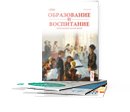This article examines the impact of media literacy on students' intercultural communication skills. Given the media’s role in shaping cultural perceptions, critical engagement helps prevent stereotypes and biases. The study highlights key aspects of media literacy, such as critical thinking, fact-checking, and identifying manipulative discourse. It also addresses challenges in multicultural education, including language barriers and cognitive biases influenced by media narratives.
Keywords : media literacy, intercultural communication, critical thinking, misinformation, higher education.
As media consumption becomes an integral part of students’ daily lives, their ability to critically engage with media content directly impacts their intercultural communication skills. In a world where cross-cultural interactions often occur in digital spaces, students encounter diverse perspectives through news articles, social media, and audiovisual content. However, without media literacy, these interactions may reinforce stereotypes rather than foster genuine understanding [1, p. 52].
Scholars emphasize that media discourse not only reflects but also constructs cultural narratives, shaping the way individuals perceive «the other» [2, p. 89]. While well-informed media consumers can identify biased narratives and misinformation, those lacking critical media skills risk misinterpreting cultural differences or falling prey to propaganda [3, p. 120]. In this context, media literacy serves as a fundamental competency for university students, enabling them to assess the credibility of information, recognize cultural biases, and engage in meaningful cross-cultural dialogue.
This article examines the role of media literacy in developing students’ intercultural communication skills. It explores key elements of media literacy, highlights its significance in countering cultural misrepresentations, and discusses pedagogical strategies for integrating media literacy education into university curricula. By fostering critical engagement with the media, educators can empower students to navigate the complexities of global communication with greater awareness and competence.
Media literacy is widely regarded as an essential competency in contemporary education, particularly in the context of intercultural communication. UNESCO defines media literacy as the ability to access, analyze, evaluate, and create media in various formats, emphasizing its role in fostering critical engagement with information [4, p. 15]. Scholars extend this definition by highlighting that media literacy is not limited to technical skills but also includes the cognitive ability to deconstruct media messages, recognize biases, and assess the reliability of sources [5, p. 67].
A fundamental aspect of media literacy is the ability to analyze and critically interpret media content. Media messages are constructed with specific purposes, often influenced by ideological, political, or commercial agendas. Researchers argue that media consumers must develop the ability to identify these influences, deconstruct narratives, and evaluate the framing of information to avoid misinterpretation and bias [6, p. 90]. This skill is particularly relevant in intercultural communication, where distorted media representations can reinforce stereotypes and hinder mutual understanding.
Another key component of media literacy is the recognition of manipulative strategies in media content. Emotional appeals, selective framing, sensationalism, and misinformation are common tools used to shape public perception. Studies indicate that individuals with advanced media literacy skills are better equipped to recognize these tactics and critically engage with content rather than passively accepting distorted information [7, p. 112]. In an era of digital communication, where media narratives spread rapidly across cultural and national boundaries, this ability is crucial in fostering objective and well-informed intercultural dialogue.
Fact-checking and source evaluation play an equally important role in media literacy. With the proliferation of misinformation and disinformation, the ability to verify claims and assess the credibility of sources has become indispensable. Scholars emphasize that effective fact-checking involves cross-referencing multiple sources, analyzing primary data, and utilizing digital verification tools to distinguish between reliable and misleading content [8, p. 143]. Research suggests that integrating these skills into higher education curricula significantly enhances students' ability to critically assess media messages, thereby contributing to more informed and effective intercultural communication [9, p. 176].
By incorporating these elements, media literacy empowers students to navigate the complexities of global communication, fostering a more critical and reflective approach to media consumption. Given the increasing influence of media on cultural perceptions and interactions, developing media literacy among university students is essential for promoting mutual understanding and reducing the risks of misinformation-driven biases in intercultural communication.
Intercultural communication is broadly defined as the process of exchanging information between individuals from different cultural backgrounds, requiring not only linguistic competence but also an understanding of cultural norms, values, and perspectives. Scholars emphasize that effective intercultural communication involves both verbal and nonverbal elements, as well as the ability to interpret cultural nuances and adapt communication strategies accordingly [10, p. 45]. In higher education, where students from diverse cultural backgrounds interact regularly, intercultural communication becomes a crucial skill for academic success and social integration.
Despite its importance, students in multicultural educational environments often face significant challenges in intercultural communication. One of the primary difficulties is the presence of cultural misunderstandings that arise from differing communication styles, social norms, and expectations. Research indicates that misinterpretations in cross-cultural settings are frequently caused by implicit assumptions based on one's native cultural framework, leading to miscommunication and frustration [11, p. 92]. Additionally, language barriers, even among students proficient in a shared language, can contribute to misunderstandings due to differences in idiomatic expressions, discourse structures, and pragmatic use of language.
Another critical factor influencing intercultural communication is the role of stereotypes and cognitive biases, often reinforced by media discourse. Media representations of different cultures can shape students' perceptions, sometimes promoting oversimplified or distorted images of other cultural groups. Scholars argue that exposure to biased media narratives can lead to unconscious prejudices, making it more difficult for students to engage in open and unbiased intercultural interactions [12, p. 118]. Furthermore, digital media and social networks play an increasingly influential role in shaping students' cultural perceptions, as algorithm-driven content may reinforce existing biases rather than promoting a more balanced understanding of cultural diversity.
Addressing these challenges requires the development of media literacy and critical thinking skills, allowing students to recognize and deconstruct biased narratives, question cultural assumptions, and approach intercultural communication with greater awareness and sensitivity. In an educational context, universities play a pivotal role in fostering these competencies through curricula that incorporate intercultural communication training, critical media analysis, and opportunities for cross-cultural engagement.
The role of media literacy in fostering effective intercultural communication among university students cannot be overstated. As media serves as a primary channel for cultural exchange, students' ability to critically engage with media messages directly impacts their understanding of different cultures. Without media literacy, students risk internalizing biased narratives, stereotypes, and misinformation, which can hinder meaningful intercultural dialogue. Developing analytical skills, recognizing manipulative media strategies, and engaging in fact-checking are essential components of media literacy that enable students to navigate global communication with greater awareness and objectivity.
Intercultural communication in an educational setting presents both opportunities and challenges. While multicultural university environments provide a platform for cross-cultural learning, students often struggle with language barriers, cultural misunderstandings, and cognitive biases shaped by media exposure. These challenges underscore the need for media literacy education, which equips students with the skills necessary to deconstruct cultural representations, critically assess the reliability of information, and approach intercultural interactions with a more informed perspective. By integrating media literacy training into university curricula, educators can help students become more competent and conscious communicators in a rapidly globalizing world.
Ultimately, media literacy is not just a tool for improving information processing but a fundamental skill that supports respectful and effective intercultural interactions. As digital media continues to shape cultural perceptions, fostering critical engagement with media content becomes a key strategy for reducing miscommunication, dismantling stereotypes, and promoting genuine cultural exchange. Universities, as centers of knowledge and social development, have a responsibility to prioritize media literacy in education, ensuring that students are not only proficient in their academic fields but also equipped with the skills necessary to engage in meaningful and constructive intercultural dialogue.
References:
- Buckingham D. The Media Education Manifesto. — Cambridge: Polity Press, 2019.
- Livingstone S. Media Literacy and the Challenge of New Information and Communication Technologies // The Communication Review. — 2004. — Т. 7, № 1. — С. 3–14. — DOI: 10.1080/10714420490280152.
- Thoman E., Jolls T. Media Literacy Education: Lessons from the Center for Media Literacy // Yearbook of the National Society for the Study of Education. — 2005. — Т. 104, № 1. — С. 180–205. — DOI: 10.1111/j.1744–7984.2005.00031.x.
- Livingstone S. Media Literacy and the Challenge of New Information and Communication Technologies // The Communication Review. — 2004. — Т. 7, № 1. — С. 3–14. — DOI: 10.1080/10714420490280152.
- Thoman E., Jolls T. Media Literacy Education: Lessons from the Center for Media Literacy // Yearbook of the National Society for the Study of Education. — 2005. — Т. 104, № 1. — С. 180–205. — DOI: 10.1111/j.1744–7984.2005.00031.x.
- Buckingham D. The Media Education Manifesto. — Cambridge: Polity Press, 2019.
- Silverblatt A. Media Literacy: Keys to Interpreting Media Messages. — Santa Barbara: Praeger, 2022.
- Kahne J., Bowyer B. Educating for Democracy in a Partisan Age: Confronting the Challenges of Motivated Reasoning and Misinformation // American Educational Research Journal. — 2017. — Т. 54, № 1. — С. 3–34. — DOI: 10.3102/0002831216679817.
- Wardle C., Derakhshan H. Information Disorder: Toward an Interdisciplinary Framework for Research and Policy Making. — Council of Europe, 2017. — URL: https://rm.coe.int/information-disorder-report-november-2017/1680764666
- Gudykunst W. B. Theorizing About Intercultural Communication. — Thousand Oaks: SAGE Publications, 2005.
- Deardorff D. K. The SAGE Handbook of Intercultural Competence. — Thousand Oaks: SAGE Publications, 2009.
- Holliday A., Hyde M., Kullman J. Intercultural Communication: An Advanced Resource Book for Students. — 2-е изд. — London: Routledge, 2021.







